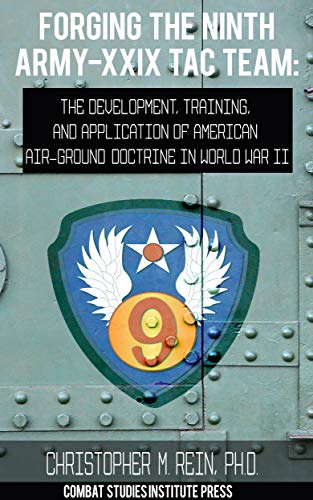
Part of Series
This book was published in 2019 and is from Combat Studies Institute Press, Army University Press, and Christopher M. Rein, Ph.D. It has a foreword, introduction, bibliography, pictures, maps, charts, and footnotes. “Christopher M. Rein’s Leavenworth Paper 24: Forging the Ninth Army-XXIX TAC Team is an excellent addition to the series. This new study looks deeply into how the US Army implemented air-ground operations in northwest Europe after Operation Overlord. Based heavily on the personal papers of key leaders, unit reports, and other primary sources, Forging the Ninth Army-XXIX TAC Team shows how the Army trained, organized, and employed its air-ground teams in 1944 and 1945. Relying heavily on experimentation, testing, and objective assessment, the Army and its air forces successfully created organizations and practices that by 1945 often proved decisive on the battlefield. “As Dr. Rein’s study points out, this success was not inevitable. Army leaders entered World War II convinced their air-ground teams were prepared for modern mechanized warfare. After costly failures early in the war, these men revised doctrine and introduced new training techniques. This account of clear-eyed adaptation and innovation then serves as a contemporary call for continued improvement in the training and application of air-ground doctrine, in ways that might mirror the US Army’s experiences in World War II. Leavenworth Paper 24, like the other studies in the series, offers critical insights from the Army’s past that can illuminate the challenges of today.” – Foreword, by Donald P. Wright (Deputy Director, Army University Press) “The combination of American ground and air power in the European Theater of World War II remains one of the most successful examples of air-ground cooperation in recorded history. By the spring of 1945, the US Army had four numbered field armies (First, Third, Seventh, and Ninth) with three allied armies (First Canadian, Second British, and First French) in an unbroken line from Switzerland to the North Sea. Each field army had an assigned tactical air command (IX, XIX, XII, and XXIX, respectively) with fighter-bombers and tactical reconnaissance aircraft assigned to provide direct support on the battlefield. 9th Air Force also had a strong force of twin-engined medium bombers, while the Strategic Air Forces (US 8th and RAF Bomber Command), which had already significantly degraded both the Luftwaffe and German industrial capacity, also stood ready to support the ground forces. Under the combined weight of this offensive, and along with a massive Soviet effort to the east which mirrored the western allies in its emphasis on tactical support aircraft, the Allies crushed the German military in the field and ended the terror of Hitler’s Third Reich. “Since the war’s end, historians have debated the relative merits of various aspects of Allied strategy and force allocation. Was the Mediterranean theater a diversion or essential preparation? Should the western Allies have advanced on Eisenhower’s “broad front,” or adopted Montgomery’s “single thrust” across the North German Plain? And what did strategic bombing actually accomplish? Sustained analysis and critique of airpower on the battlefield is often lost in these debates. After being almost forgotten in the wake of the war, when nuclear weapons appeared to make large-scale ground combat impossible, the topic received a resurgence in attention beginning in the mid-1980s with Dan Mortensen’s path-breaking work.” - Introduction


